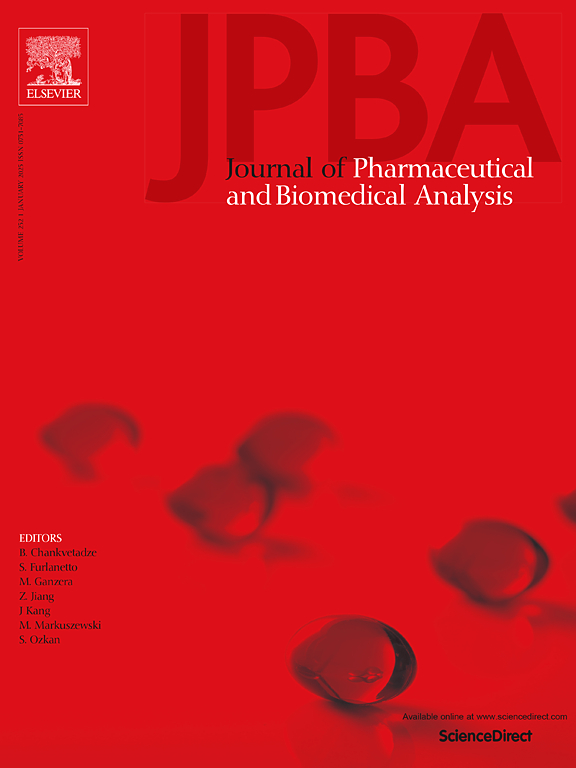N-doped graphene quantum dots combined with Ag nanoparticles for luminescence based analytical sensing of gentamycin after solid-phase extraction in a molecularly-imprinted polymer
IF 3.1
3区 医学
Q2 CHEMISTRY, ANALYTICAL
Journal of pharmaceutical and biomedical analysis
Pub Date : 2025-03-07
DOI:10.1016/j.jpba.2025.116795
引用次数: 0
Abstract
A luminescence-based method was developed to detect gentamicin using silver nanoparticles (AgNPs) associated with nitrogen-doped graphene quantum dots (N-GQDs). When gentamicin sulfate interacts with the AgNPs/N-GQDs system, the characteristic blue fluorescence of N-GQDs, which had been previously turned off by AgNPs, is restored. Under specific conditions (such as the amount of synthesis dispersion and pH), this AgNPs/N-GQDs probe enabled quantification of gentamicin ranging from 3.0 × 10−7 to 6.0 × 10−6 mol L−1. To address interference from other substances during the analysis, a solid-phase extraction, with a kanamycin-imprinted polymer cartridge, enabled accurate results. Two veterinary pharmaceutical samples were used to test the method and results were in agreement with those achieved by obtained using high-performance liquid chromatography with analyte chemical derivatization. This new method is straightforward, sensitive, and selective, and it is also considered eco-friendly (0.63 score Analytical greenness calculator) since it avoids the use of toxic chemical derivatization reagents, use nanoquantities of carbon and silver based nanomaterials and aqueous systems.
求助全文
约1分钟内获得全文
求助全文
来源期刊
CiteScore
6.70
自引率
5.90%
发文量
588
审稿时长
37 days
期刊介绍:
This journal is an international medium directed towards the needs of academic, clinical, government and industrial analysis by publishing original research reports and critical reviews on pharmaceutical and biomedical analysis. It covers the interdisciplinary aspects of analysis in the pharmaceutical, biomedical and clinical sciences, including developments in analytical methodology, instrumentation, computation and interpretation. Submissions on novel applications focusing on drug purity and stability studies, pharmacokinetics, therapeutic monitoring, metabolic profiling; drug-related aspects of analytical biochemistry and forensic toxicology; quality assurance in the pharmaceutical industry are also welcome.
Studies from areas of well established and poorly selective methods, such as UV-VIS spectrophotometry (including derivative and multi-wavelength measurements), basic electroanalytical (potentiometric, polarographic and voltammetric) methods, fluorimetry, flow-injection analysis, etc. are accepted for publication in exceptional cases only, if a unique and substantial advantage over presently known systems is demonstrated. The same applies to the assay of simple drug formulations by any kind of methods and the determination of drugs in biological samples based merely on spiked samples. Drug purity/stability studies should contain information on the structure elucidation of the impurities/degradants.

 求助内容:
求助内容: 应助结果提醒方式:
应助结果提醒方式:


